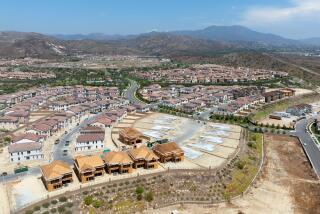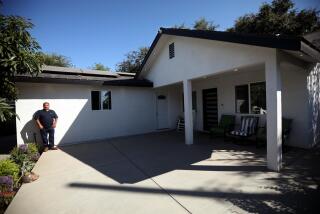New-home buyers reemerge in Southern California
The modest house has yet to be shingled and a stack of drywall sits on the bare concrete floor, but Karame Adesko and her fiance, Pablo Garcia, can envision their future in this developing Corona cul-de-sac.
Adesko and Garcia originally planned to buy one of the many foreclosed properties in Southern California. But after touring several and seeing the pricey repairs they needed, the couple opted to spend $309,000 on a new 1,300-square-foot home.
“You don’t want to spend all this money and then have to fix everything up,” said Adesko, a 27-year-old dance instructor. “I wanted to buy a move-in-ready house.”
Helped by people like Garcia and Adesko, sales of new homes are on the upswing. Buyers purchased 3,447 new homes in Southern California during the first three months of the year, a 17% increase from the same period last year, according to the San Diego research firm MDA DataQuick.
That’s a fraction of what sales were during the peak of the region’s housing boom; in the first quarter of 2006, builders sold 17,324 new homes in Southern California. Gone too are the days when developers built on spec, confident that buyers armed with easy credit would line up to purchase the finished product.
Still, there are signs of a rebound. Nationwide, sales of new homes jumped 27% in March from the month before and 24% compared with March 2009. A key index of homebuilder stocks is up 16% this year, compared with a rise of 3.4% in the Dow index. One major builder, Lennar Corp., has seen its shares rocket 47%.
Experts say new-home sales have been helped by state and federal tax credits, as well as by new tactics by builders adjusting to the no-frills post-bubble environment.
Simple floor plans, stucco facades and energy-saving appliances are in. Mini-mansions with marble countertops, Jacuzzi tubs, big curving staircases and high vaulted ceilings are out.
“In 2005, you didn’t need a down payment and you figured the home would continue its appreciation in value, so people wanted big homes that were completely decked out,” Irvine economist John Burns said. “Now you are getting a home with four corners and a roof.”
Location is also key, analysts said, with buyers less willing to commute extreme distances for affordable housing.
Builders, too, have grown more cautious. Now many will begin construction only after a buyer has put down a deposit or signed a contract. They include KB Home, the Los Angeles company that’s building Adesko and Garcia’s house. KB shares have risen 21% this year, although shares slipped Thursday on an analyst’s downgrade.
The firm has scaled back its more elaborate architectural offerings, focusing instead on a collection of simple floor plans it calls its Open Series.
The shift has helped KB Home grab the biggest market share in Southern California — 7.7% in the first quarter, according to research firm Hanley Wood Market Intelligence. The average price of those properties was $373,341, Hanley Wood said, nearly one-third lower than the $549,081 in the first quarter of 2006.
Shea Homes, a privately held builder based in Walnut, has also introduced a line of smaller homes with modern design, scaled-down master bathrooms and interior spaces that can be reconfigured, said Patrick Duffy, principal for research firm MetroIntelligence Real Estate Advisors.
“They have gone back and they have reengineered their entire production process,” Duffy said. “Where can we find economies of scale, where can we cut price, where can we simplify?”
Despite the uptick in new-home sales, analysts expect this to be a challenging year for builders. Foreclosures continue to hit the housing market. Consumers remain saddled with debt. The nation’s labor market is weak. Banks have tightened lending standards. And the generous government tax breaks, which helped fuel sales in recent months, expired at the end of April.
Still, the large, publicly traded companies that dominate the market have plenty of cash and are well positioned to ramp up production when demand picks up, Burns said.
“You have companies today who can build homes, and you didn’t have that in the early 1990s,” after the last housing crash, he said. “We should see construction increase more quickly this cycle.”
Builders are also beginning to look beyond first-time buyers and launching pricier developments.
Later this month, Miami-based Lennar plans to open Central Park West in Irvine, a project it had put on hold during the housing crash. The master-planned, 42-acre community will feature 1,380 residences including luxury condominiums, flats, lofts and town homes with prices ranging from the upper $300,000s to more than $1 million.
Pulte Homes, based in Bloomfield Hills, Mich., is opening a new development in Northeast Pasadena on a five-acre parcel of land it bought late last year. The company, whose stock has climbed 18% this year, is selling 35 homes with three floor plans ranging in size from 2,565 square feet to 2,898 square feet, with prices starting in the high $700,000s.
“We are starting to see activity from some of the public homebuilders — acquiring land and really positioning themselves for what they seem to read as a recovery in the housing market,” said Emile Haddad, chief executive of Five Point Communities, a Lennar spinoff.
Although price remains a crucial factor for many first-time homebuyers, location has also taken on new importance.
“Unlike 2005 and 2006, people are not going to just buy homes for the price and deal with the commute later. They are actually looking for location again, which is the key thing, which is still keeping the new-home sales low,” said Michael Ellison, Southern California sales director for Hanley Wood.
Corona, with plenty of land and relative proximity to Orange County, has taken off as a building hub. More than 900 new homes have been sold in the area over the last 15 months, according to Hanley Wood.
Adesko and Garcia bought in a subdivision known as Alpine at Willow Ranch. Although the project has a pastoral feel, set amid dairy farms and with views of the snow-capped San Gabriel Mountains, it’s not far from her job in Placentia and his in Yorba Linda.
Directional signs with names of some of the biggest builders greet people disembarking from Interstate 15. Colorful banners and billboards advertise homes’ prices and features. Marketers stand on street corners, defying an unforgiving sun, spinning cardboard arrows in hopes of drawing in traffic.
One recent morning, Adesko and Garcia were led on a tour of their future home by Arnold Lloyd, a KB Home superintendent with an impressive handlebar mustache and long, thick, white sideburns. He explained the home’s features, showing them their property line, energy-saving air conditioner and gas fireplace.
“You just have to turn the switch on and you have instant romance,” he said. “You can sit back and enjoy your glass of wine.”
“Nice,” Adesko said.
More to Read
Inside the business of entertainment
The Wide Shot brings you news, analysis and insights on everything from streaming wars to production — and what it all means for the future.
You may occasionally receive promotional content from the Los Angeles Times.










